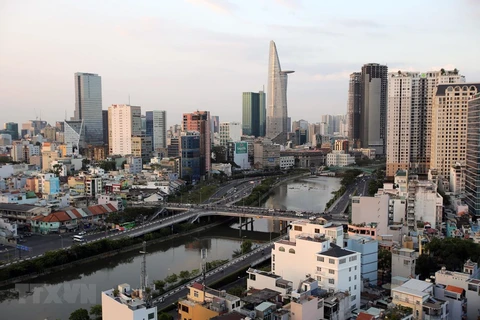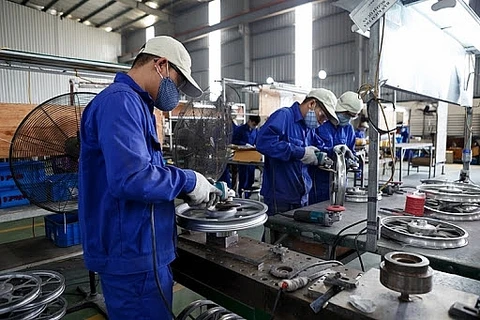HCM City (VNS/VNA) - Eighty-three percent of companies in the physical value chain in Vietnam have been suffering from supply issues over the past two months due to the impact of the COVID-19 pandemic, a recent survey by CEL Vietnam, a supply chain consulting and training firm, has found.
Of them, 47 percent had issues specifically with China supplies and a large majority involved raw materials, it said.
Julien Brun, managing partner at CEL, said the pandemic is affecting every single country regardless of their level of development.
However, in Vietnam, there were categories where demand clearly surged, such as packaged food (up 26 percent), dairy (up 10 percent) and personal care (29 percent), he said.
This surge in demand looked like a “just in case” purchase decision, a stock-up behaviour, and not a healthy increase in consumption, he explained.
But the reality is that the actual demand is at a low, with sales of beverages, fashion goods, electronics, vehicles, agricultural products, furniture, footwear, and many other products coming to a halt both locally and globally, he said.
“As we speak, in Vietnam and elsewhere, manufacturers and retailers’ current sales volumes are too low to absorb [even] fixed costs, leaving thousands of businesses with negative margins and thin reserves of cash.
“Export dependent companies are seeing orders cancelled every day, particularly from the EU and the US. As a consequence, the global transport sector is also being affected and freight forwarders in Vietnam are seeing their volume drop by 25 to 70 percent.”
A number of SMEs have already declared bankruptcy, and for others the impact on human resources, the main adjustment variable, is being felt strongly and unemployment is threatening multiple industries, he said.
CEL also found that companies operating in retail, distribution and logistics services (excluding e-commerce and last mile delivery) reported a loss of revenue of 25 percent in the first quarter and do not expect to recover this loss this year.
Urban consumers seek convenient and safe shopping alternatives for their daily family needs amid the COVID-19 threats, and e-commerce and home delivery services have become central to this evolution, it said.
Brun said: “Figures are still not officially published in Vietnam, but Lazada reported a 300 percent increase in the number of orders in Singapore and Grab delivery surged by 200 percent in Bangkok. We can assume that comparable growth is being seen in the main cities in Vietnam.”
So a large volume has shifted from offline to online distribution channels and last mile delivery companies are barely able to cope with the surge in delivery orders, he said.
One of the main challenges this shift creates is the ability to transfer goods over long distances, such as between the north and the south, since air and rail transport are constrained, he said. Long-haul trucks have become scarce and the lack of transport capacity generates delays and extra disruptions, he said.
As people start getting accustomed to more systematic online purchase and home deliveries, it is likely that this becomes a habit, and it is likely that the post-crisis situation would still benefit the e-commerce and delivery sector while the offline retail sector slowly recovers, he predicted.
“This is certainly a fundamental new trend in the consumer goods industry that we have to keep in mind. The crisis will also further accelerate the e-government initiative, allowing the population to fulfill their administrative duties online and thus avoiding long physical queues. Once the crisis ends, it is likely that the implementation of digital solutions for consumers and citizens will increase drastically.”/.
Of them, 47 percent had issues specifically with China supplies and a large majority involved raw materials, it said.
Julien Brun, managing partner at CEL, said the pandemic is affecting every single country regardless of their level of development.
However, in Vietnam, there were categories where demand clearly surged, such as packaged food (up 26 percent), dairy (up 10 percent) and personal care (29 percent), he said.
This surge in demand looked like a “just in case” purchase decision, a stock-up behaviour, and not a healthy increase in consumption, he explained.
But the reality is that the actual demand is at a low, with sales of beverages, fashion goods, electronics, vehicles, agricultural products, furniture, footwear, and many other products coming to a halt both locally and globally, he said.
“As we speak, in Vietnam and elsewhere, manufacturers and retailers’ current sales volumes are too low to absorb [even] fixed costs, leaving thousands of businesses with negative margins and thin reserves of cash.
“Export dependent companies are seeing orders cancelled every day, particularly from the EU and the US. As a consequence, the global transport sector is also being affected and freight forwarders in Vietnam are seeing their volume drop by 25 to 70 percent.”
A number of SMEs have already declared bankruptcy, and for others the impact on human resources, the main adjustment variable, is being felt strongly and unemployment is threatening multiple industries, he said.
CEL also found that companies operating in retail, distribution and logistics services (excluding e-commerce and last mile delivery) reported a loss of revenue of 25 percent in the first quarter and do not expect to recover this loss this year.
Urban consumers seek convenient and safe shopping alternatives for their daily family needs amid the COVID-19 threats, and e-commerce and home delivery services have become central to this evolution, it said.
Brun said: “Figures are still not officially published in Vietnam, but Lazada reported a 300 percent increase in the number of orders in Singapore and Grab delivery surged by 200 percent in Bangkok. We can assume that comparable growth is being seen in the main cities in Vietnam.”
So a large volume has shifted from offline to online distribution channels and last mile delivery companies are barely able to cope with the surge in delivery orders, he said.
One of the main challenges this shift creates is the ability to transfer goods over long distances, such as between the north and the south, since air and rail transport are constrained, he said. Long-haul trucks have become scarce and the lack of transport capacity generates delays and extra disruptions, he said.
As people start getting accustomed to more systematic online purchase and home deliveries, it is likely that this becomes a habit, and it is likely that the post-crisis situation would still benefit the e-commerce and delivery sector while the offline retail sector slowly recovers, he predicted.
“This is certainly a fundamental new trend in the consumer goods industry that we have to keep in mind. The crisis will also further accelerate the e-government initiative, allowing the population to fulfill their administrative duties online and thus avoiding long physical queues. Once the crisis ends, it is likely that the implementation of digital solutions for consumers and citizens will increase drastically.”/.
VNA
























